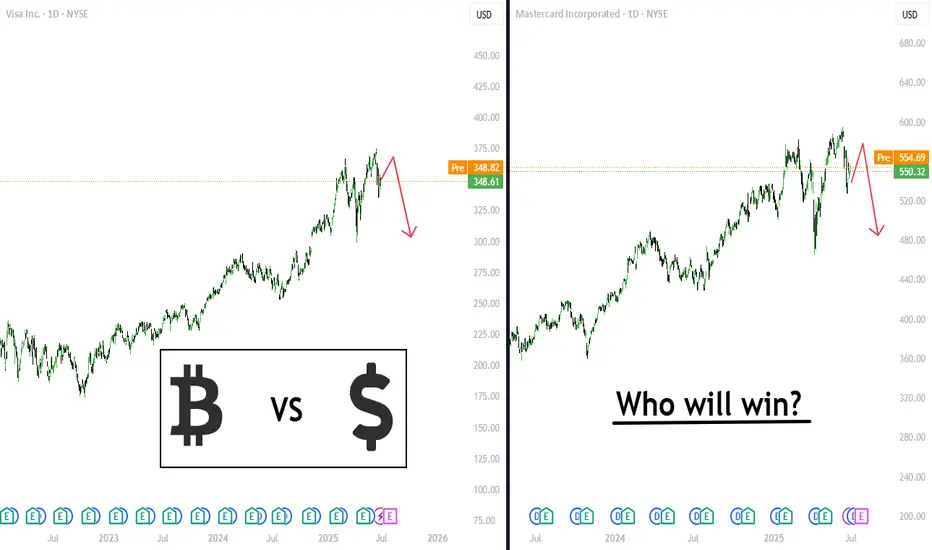How Stablecoin Payments Can Hurt Visa & Mastercard
Bypassing the Interchange System
-Stablecoins allow peer-to-peer or business-to-consumer payments without using credit/debit card rails.
-Visa & Mastercard earn billions from interchange fees (0.1%–3% per transaction). If people pay directly via a stablecoin wallet (e.g. USDC, USDT), these fees vanish.
Faster, Cheaper Cross-Border Payments
-Traditional card transactions (especially international) can be slow and expensive.
-Stablecoins on blockchains like Solana or Ethereum L2s allow near-instant settlement with near-zero fees, reducing the demand for VisaNet and Mastercard systems.
Merchant Preference
-Merchants often pay 1–3% in processing fees to card networks.
-Accepting stablecoins directly = zero or minimal fees, increasing merchant pressure to move away from cards.
Fintech Adoption
-Companies like Stripe, PayPal, Shopify, and Square are integrating stablecoins.
-If these platforms offer cheaper stablecoin settlement options, users and merchants may shift away from traditional card use.
How Visa & Mastercard Could Defend or Adapt
Partner with Stablecoin Networks
-Both companies are already testing stablecoin payments:
-Visa is piloting USDC settlements on Solana and Ethereum.
-Mastercard partnered with Paxos and others to test blockchain-based settlements.
These moves show they're not ignoring the shift, but trying to build rails for stablecoins too.
Act as On-/Off-Ramps
-They can remain dominant as the entry and exit point between fiat and crypto (e.g. buying crypto with cards, or topping up crypto wallets).
-This maintains transaction volume even if some purchases happen in stablecoin.
Expand to B2B and API Infrastructure
-Visa and Mastercard are expanding into B2B transactions, open banking, and embedded finance APIs (e.g. Visa Direct, Mastercard Send).
-This diversifies revenue beyond retail card swipes.
Leverage Network Trust
-Stablecoins may lack consumer protection (fraud protection, chargebacks).
-Visa and Mastercard can market themselves as the trusted rails for consumers and businesses — especially in fraud-prone areas.
-Disclaimer: This analysis is for informational and educational purposes only and does not constitute financial advice, investment recommendation, or an offer to buy or sell any securities. Stock prices, valuations, and performance metrics are subject to change and may be outdated. Always conduct your own due diligence and consult with a licensed financial advisor before making investment decisions. The information presented may contain inaccuracies and should not be solely relied upon for financial decisions. I am not personally liable for your own losses, this is not financial advise.
Bypassing the Interchange System
-Stablecoins allow peer-to-peer or business-to-consumer payments without using credit/debit card rails.
-Visa & Mastercard earn billions from interchange fees (0.1%–3% per transaction). If people pay directly via a stablecoin wallet (e.g. USDC, USDT), these fees vanish.
Faster, Cheaper Cross-Border Payments
-Traditional card transactions (especially international) can be slow and expensive.
-Stablecoins on blockchains like Solana or Ethereum L2s allow near-instant settlement with near-zero fees, reducing the demand for VisaNet and Mastercard systems.
Merchant Preference
-Merchants often pay 1–3% in processing fees to card networks.
-Accepting stablecoins directly = zero or minimal fees, increasing merchant pressure to move away from cards.
Fintech Adoption
-Companies like Stripe, PayPal, Shopify, and Square are integrating stablecoins.
-If these platforms offer cheaper stablecoin settlement options, users and merchants may shift away from traditional card use.
How Visa & Mastercard Could Defend or Adapt
Partner with Stablecoin Networks
-Both companies are already testing stablecoin payments:
-Visa is piloting USDC settlements on Solana and Ethereum.
-Mastercard partnered with Paxos and others to test blockchain-based settlements.
These moves show they're not ignoring the shift, but trying to build rails for stablecoins too.
Act as On-/Off-Ramps
-They can remain dominant as the entry and exit point between fiat and crypto (e.g. buying crypto with cards, or topping up crypto wallets).
-This maintains transaction volume even if some purchases happen in stablecoin.
Expand to B2B and API Infrastructure
-Visa and Mastercard are expanding into B2B transactions, open banking, and embedded finance APIs (e.g. Visa Direct, Mastercard Send).
-This diversifies revenue beyond retail card swipes.
Leverage Network Trust
-Stablecoins may lack consumer protection (fraud protection, chargebacks).
-Visa and Mastercard can market themselves as the trusted rails for consumers and businesses — especially in fraud-prone areas.
-Disclaimer: This analysis is for informational and educational purposes only and does not constitute financial advice, investment recommendation, or an offer to buy or sell any securities. Stock prices, valuations, and performance metrics are subject to change and may be outdated. Always conduct your own due diligence and consult with a licensed financial advisor before making investment decisions. The information presented may contain inaccuracies and should not be solely relied upon for financial decisions. I am not personally liable for your own losses, this is not financial advise.
Disclaimer
The information and publications are not meant to be, and do not constitute, financial, investment, trading, or other types of advice or recommendations supplied or endorsed by TradingView. Read more in the Terms of Use.
Disclaimer
The information and publications are not meant to be, and do not constitute, financial, investment, trading, or other types of advice or recommendations supplied or endorsed by TradingView. Read more in the Terms of Use.
